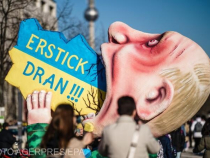Sino-Russian axis is expected to reach a new apogee since the two countries would be working on the deepening of their energy cooperation through the joint development of nuclear- and wind-powered projects in the Arctic. Until recently the resource-rich region was eyed by China exclusively from the point of view of the gas exploitation and of the construction of the so-called Polar Silk Road, but things are quickly changing as shown by the moves of the State Grid Corporation of China (SGCC), that is Beijing’s electric utility company and the world-largest in the electric power industry.
Arctic Wind is the key
Ou Xiaoming, chief representative of SGCC in Russia, declared that the company is very interested in offering its expertise and know-how to Moscow in order to help the country reach the much-aspired goal of diversifying the energy industry and start the emancipation from the fossil fuel dependency – a target that China dreams to achieve as well by the mid-century.
To date, China’s involvement in the Arctic is limited to the financing of Russian-owned liquefied natural gas plants Yamal and Arctic 2, the latter is under construction, from which the Kremlin plans to extract most of the gas that will supply Eurasian markets in the coming years, but the country aims at convincing the Russian partner to open a resource sharing policy. China aspires to satisfy all of its domestic electricity demand from wind power by 2050s and, to do so, is raising its generation capacity yearly and has started looking at North. The reason is simple: according to Russian-owned company Rosnono, the Arctic and the Far East provide the country with the world-biggest potential for wind power generation, but the sector is scarcely developed and the Ukraine-related sanctions regime affects as well the purchase of Western-made high tech which could prove useful.
Russia’s long-term energy agenda speaks clearly: fossil fuels represent the present, but renewable energy is the future. China is recognized globally as the world leader in wind power generation and, to date, is Russia’s only chance to develop the sector due to the ongoing sanctions.
Xiaoming’s claims that SGCC is already in talks to enter the Arctic are the latest proof that China’s Russian-friendly revolutionary policy is making history and re-making the world order according to Beijing wishes. The agreement that the company and the Kremlin are set to reach soon is likely to take a do ut des-modelled form: Chinese know-how and technology in exchange for percentages of energy.
What is next?
During the 2019 Saint Petersburg International Economic Forum, Russia and China agreed on deepening energy cooperation in every relevant-considered field: from trade to production chain and exploration. The Arctic was at the center of the talks and particularly important was the focus given on the joint development and exploitation of the regional resources.
Xiaoming’s claims show that China thinks that the moment has come to go further to the mere oil and gas trade to try to open new fronts of collaboration in which the country ends to play the junior part as regard to energy. China needs renewables, Russia needs know-how and money, the conditions for a win-win agreement are present.
But when the matter is energy security the risks are beyond the corner. The opening of a resource sharing policy in the medium-term may lead to dangerous misunderstandings and tries of trespassings from both parts, which are already divided by a series of still-unsolved issues. A deepened energy cooperation may be the key for a strong alliance or the cause of a traumatic divorce.
DefenseRomania App
Fii primul care află cele mai importante știri din domeniu cu aplicația DefenseRomania. Downloadează aplicația DefenseRomania de pe telefonul tău Android (Magazin Play) sau iOS (App Store) și ești la un click distanță de noi în permanență
Fiți la curent cu ultimele noutăți. Urmăriți DefenseRomania și pe Google News









































